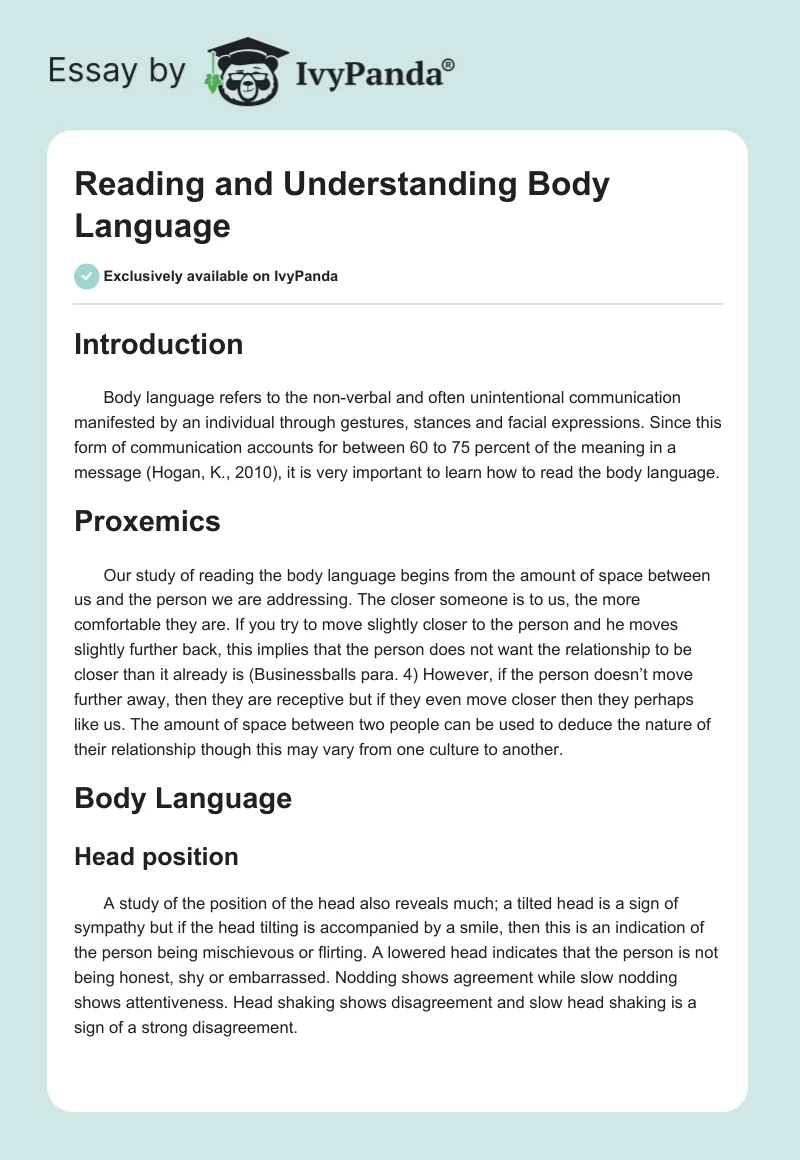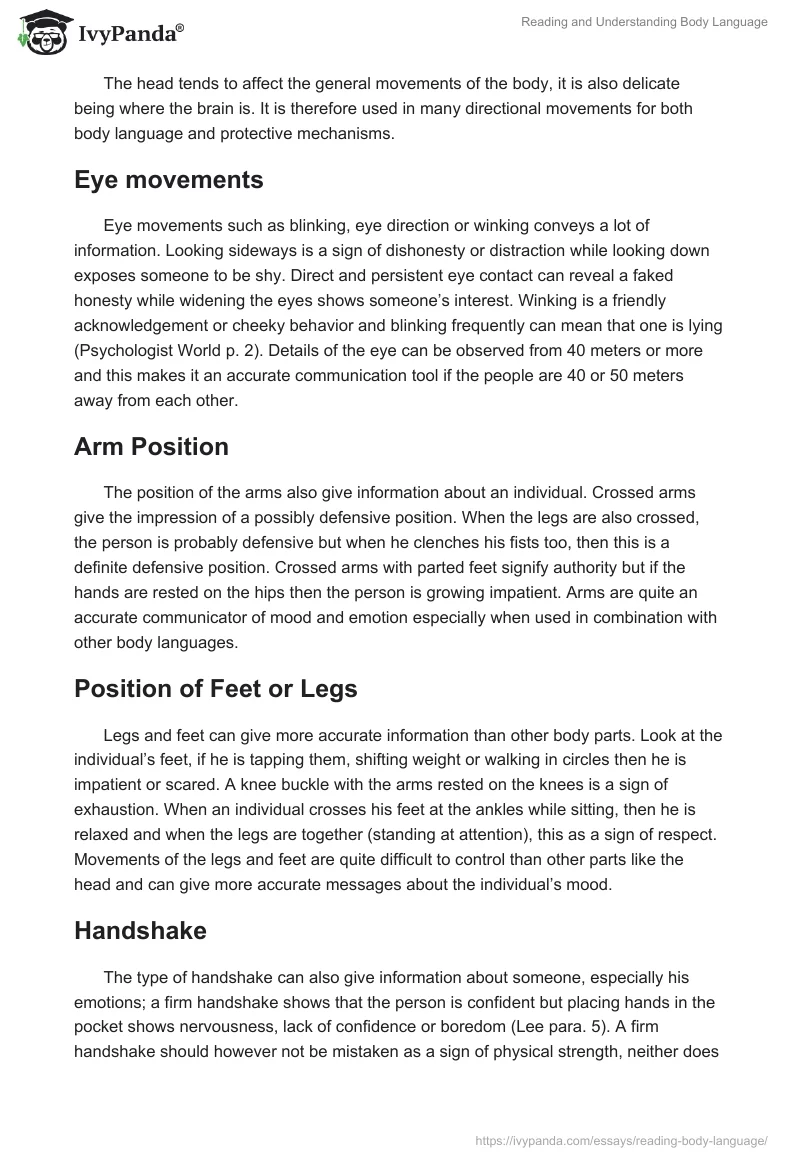Introduction
Body language refers to the non-verbal and often unintentional communication manifested by an individual through gestures, stances and facial expressions. Since this form of communication accounts for between 60 to 75 percent of the meaning in a message (Hogan, K., 2010), it is very important to learn how to read the body language.
Proxemics
Our study of reading the body language begins from the amount of space between us and the person we are addressing. The closer someone is to us, the more comfortable they are. If you try to move slightly closer to the person and he moves slightly further back, this implies that the person does not want the relationship to be closer than it already is (Businessballs para. 4) However, if the person doesn’t move further away, then they are receptive but if they even move closer then they perhaps like us. The amount of space between two people can be used to deduce the nature of their relationship though this may vary from one culture to another.
Body Language
Head position
A study of the position of the head also reveals much; a tilted head is a sign of sympathy but if the head tilting is accompanied by a smile, then this is an indication of the person being mischievous or flirting. A lowered head indicates that the person is not being honest, shy or embarrassed. Nodding shows agreement while slow nodding shows attentiveness. Head shaking shows disagreement and slow head shaking is a sign of a strong disagreement.
The head tends to affect the general movements of the body, it is also delicate being where the brain is. It is therefore used in many directional movements for both body language and protective mechanisms.
Eye movements
Eye movements such as blinking, eye direction or winking conveys a lot of information. Looking sideways is a sign of dishonesty or distraction while looking down exposes someone to be shy. Direct and persistent eye contact can reveal a faked honesty while widening the eyes shows someone’s interest. Winking is a friendly acknowledgement or cheeky behavior and blinking frequently can mean that one is lying (Psychologist World p. 2). Details of the eye can be observed from 40 meters or more and this makes it an accurate communication tool if the people are 40 or 50 meters away from each other.
Arm Position
The position of the arms also give information about an individual. Crossed arms give the impression of a possibly defensive position. When the legs are also crossed, the person is probably defensive but when he clenches his fists too, then this is a definite defensive position. Crossed arms with parted feet signify authority but if the hands are rested on the hips then the person is growing impatient. Arms are quite an accurate communicator of mood and emotion especially when used in combination with other body languages.
Position of Feet or Legs
Legs and feet can give more accurate information than other body parts. Look at the individual’s feet, if he is tapping them, shifting weight or walking in circles then he is impatient or scared. A knee buckle with the arms rested on the knees is a sign of exhaustion. When an individual crosses his feet at the ankles while sitting, then he is relaxed and when the legs are together (standing at attention), this as a sign of respect. Movements of the legs and feet are quite difficult to control than other parts like the head and can give more accurate messages about the individual’s mood.
Handshake
The type of handshake can also give information about someone, especially his emotions; a firm handshake shows that the person is confident but placing hands in the pocket shows nervousness, lack of confidence or boredom (Lee para. 5). A firm handshake should however not be mistaken as a sign of physical strength, neither does it have a meaning of a positive mood or persona. When the handshake is done using both hands, then the person is trying to win your trust or showing his honesty. This type of handshake could also mean that the person is trying to extend his control over you. Sweaty palms could be a sign of dishonesty, this type of body language is also prone to misinterpretation since a medical condition known as Hyperhidrosis also causes sweating of the palms and feet (Businessballs para. 12). Finger play is commonly practiced by children and is a sign that the child is telling a lie or is being dishonest in some way.
Voice
Our body language study now focuses on the voice; the tone, pitch or volume of the voice all give meaning about you. Yelling shows that an individual has lost control of a situation while a lack of tonal variation is a sign of boredom (LessonPlans para. 6). Boredom is also exhibited by use of one-sentence answers while an energetic voice tone shows that the person is confident. The voice is prone to misunderstanding and must be carefully used, some people are used to speaking in a loud voice and this may be misinterpreted to mean rudeness.
Conclusion
While body language can be used to gather more information than verbal communication, misinterpretations can easily occur especially if the people are not from the same culture. Different gestures or facial expressions have different meanings in different societies; therefore, analysis of a body language becomes more accurate when used in combination with other forms of communication.
Certain bodily signals are known to be due to medical conditions, examples include Hyperhidrosis, which causes sweating of palms, and Astigmatism, which causes defects in the eye and may be mistaken to mean that one is avoiding eye contact. Cultures also have different interpretations for the different body languages; avoiding eye is a sign of respect in some Black Caribbean cultures but is a sign of dishonesty in the Western cultures.
References
- Businessballs. Body Language: how to read body language signs and gestures – non- verbal communications – male and female, for work, social, dating, and mating relationships. 2010. Web.
- Hogan, K. Secrets of How to Read Body Language. 2010. Web.
- Lee, M. Reading Body Language. 2010.
- Lesson Plans Inc.Tone of Voice and Nonverbal Body Language.2010. Web.
- Psychologist World. Reading the Eyes. 2010. Web.


